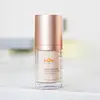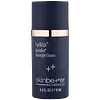What's inside
What's inside
 Key Ingredients
Key Ingredients

 Benefits
Benefits

 Concerns
Concerns

 Ingredients Side-by-side
Ingredients Side-by-side

Water
Skin ConditioningEthylhexyl Olivate
Skin ConditioningPentylene Glycol
Skin ConditioningGlycerin
HumectantEthylhexyl Palmitate
EmollientCI 77220
Cosmetic ColorantCetyl Alcohol
EmollientNiacinamide
SmoothingGlyceryl Stearate
EmollientDiheptyl Succinate
EmollientPropanediol
SolventSilica
AbrasiveC10-18 Triglycerides
EmollientPortulaca Oleracea Extract
Skin ConditioningHydrolyzed Sodium Hyaluronate 1%
Skin ConditioningMyrciaria Dubia Fruit Extract
Skin ConditioningPhaseolus Radiatus Seed Extract
Skin ConditioningLeuconostoc/Radish Root Ferment Filtrate
AntimicrobialSambucus Nigra Flower Extract
RefreshingSodium Hyaluronate Crosspolymer
HumectantAcacia Decurrens Flower Wax
EmollientSqualane
EmollientHelianthus Annuus Seed Wax
Skin ConditioningSclerocarya Birrea Seed Oil
HumectantAcetyl Tetrapeptide-11
Skin ConditioningAcetyl Tetrapeptide-9
Skin ConditioningDimethyl Isosorbide
SolventSteareth-20
CleansingButylene Glycol
Humectant3-O-Ethyl Ascorbic Acid
Skin ConditioningGlyceryl Behenate
EmollientC13-14 Isoparaffin
EmollientBenzoic Acid
MaskingPolysorbate 20
EmulsifyingPEG-75 Stearate
Capryloyl Glycerin/Sebacic Acid Copolymer
Skin ConditioningTocopheryl Acetate
AntioxidantSorbitan Caprylate
EmulsifyingPolysorbate 80
EmulsifyingXanthan Gum
EmulsifyingTetradecane
PerfumingDecyl Glucoside
CleansingPolyglycerin-3
HumectantStearyl Alcohol
EmollientHexylene Glycol
EmulsifyingJojoba Esters
EmollientSclerotium Gum
Emulsion StabilisingLecithin
EmollientPullulan
Caprylyl Glycol
EmollientPanthenol
Skin ConditioningSodium Hydroxide
BufferingCeteth-20
CleansingHea/Sodium Acryloyldimethyltaurate/Steareth-20 Methacrylate Copolymer
Emulsion StabilisingEthylhexylglycerin
Skin ConditioningPhenoxyethanol
PreservativeCitric Acid
BufferingWater, Ethylhexyl Olivate, Pentylene Glycol, Glycerin, Ethylhexyl Palmitate, CI 77220, Cetyl Alcohol, Niacinamide, Glyceryl Stearate, Diheptyl Succinate, Propanediol, Silica, C10-18 Triglycerides, Portulaca Oleracea Extract, Hydrolyzed Sodium Hyaluronate 1%, Myrciaria Dubia Fruit Extract, Phaseolus Radiatus Seed Extract, Leuconostoc/Radish Root Ferment Filtrate, Sambucus Nigra Flower Extract, Sodium Hyaluronate Crosspolymer, Acacia Decurrens Flower Wax, Squalane, Helianthus Annuus Seed Wax, Sclerocarya Birrea Seed Oil, Acetyl Tetrapeptide-11, Acetyl Tetrapeptide-9, Dimethyl Isosorbide, Steareth-20, Butylene Glycol, 3-O-Ethyl Ascorbic Acid, Glyceryl Behenate, C13-14 Isoparaffin, Benzoic Acid, Polysorbate 20, PEG-75 Stearate, Capryloyl Glycerin/Sebacic Acid Copolymer, Tocopheryl Acetate, Sorbitan Caprylate, Polysorbate 80, Xanthan Gum, Tetradecane, Decyl Glucoside, Polyglycerin-3, Stearyl Alcohol, Hexylene Glycol, Jojoba Esters, Sclerotium Gum, Lecithin, Pullulan, Caprylyl Glycol, Panthenol, Sodium Hydroxide, Ceteth-20, Hea/Sodium Acryloyldimethyltaurate/Steareth-20 Methacrylate Copolymer, Ethylhexylglycerin, Phenoxyethanol, Citric Acid
Water
Skin ConditioningPropanediol
SolventIsocetyl Stearoyl Stearate
EmollientGlyceryl Stearate
EmollientC10-18 Triglycerides
EmollientGlycerin
HumectantJojoba Esters
EmollientNiacinamide
SmoothingEthylhexyl Olivate
Skin ConditioningPolyglyceryl-6 Palmitate/Succinate
EmulsifyingCoco-Caprylate/Caprate
EmollientHydroxypropyl Starch Phosphate
Cetearyl Alcohol
EmollientTriheptanoin
Skin ConditioningButylene Glycol
HumectantDimethyl Isosorbide
SolventEthyl Lactyl Retinoate
AbrasiveAcetyl Hexapeptide-37
Skin ConditioningSodium Hyaluronate
HumectantGlyceryl Glucoside
HumectantLeontopodium Alpinum Flower/Leaf Extract
Skin ConditioningChamomilla Recutita Flower Extract
MaskingAstaxanthin
Skin ConditioningHaematococcus Pluvialis Extract
AntioxidantCrataegus Monogyna Flower Extract
Skin ConditioningJasminum Sambac Flower Extract
MaskingTocopheryl Acetate
AntioxidantHydrolyzed Jojoba Esters
Skin ConditioningTremella Fuciformis Extract
HumectantTocopherol
AntioxidantPotassium Cetyl Phosphate
EmulsifyingSucrose Stearate
EmollientC9-12 Alkane
SolventGluconolactone
Skin ConditioningCalcium Gluconate
HumectantPolyurethane-10
Ethylhexylglycerin
Skin ConditioningAmmonium Polyacryloyldimethyl Taurate
Emulsion StabilisingSodium Phytate
Citric Acid
BufferingPhenoxyethanol
PreservativeSodium Benzoate
MaskingPotassium Sorbate
PreservativeWater, Propanediol, Isocetyl Stearoyl Stearate, Glyceryl Stearate, C10-18 Triglycerides, Glycerin, Jojoba Esters, Niacinamide, Ethylhexyl Olivate, Polyglyceryl-6 Palmitate/Succinate, Coco-Caprylate/Caprate, Hydroxypropyl Starch Phosphate, Cetearyl Alcohol, Triheptanoin, Butylene Glycol, Dimethyl Isosorbide, Ethyl Lactyl Retinoate, Acetyl Hexapeptide-37, Sodium Hyaluronate, Glyceryl Glucoside, Leontopodium Alpinum Flower/Leaf Extract, Chamomilla Recutita Flower Extract, Astaxanthin, Haematococcus Pluvialis Extract, Crataegus Monogyna Flower Extract, Jasminum Sambac Flower Extract, Tocopheryl Acetate, Hydrolyzed Jojoba Esters, Tremella Fuciformis Extract, Tocopherol, Potassium Cetyl Phosphate, Sucrose Stearate, C9-12 Alkane, Gluconolactone, Calcium Gluconate, Polyurethane-10, Ethylhexylglycerin, Ammonium Polyacryloyldimethyl Taurate, Sodium Phytate, Citric Acid, Phenoxyethanol, Sodium Benzoate, Potassium Sorbate
Ingredients Explained
These ingredients are found in both products.
Ingredients higher up in an ingredient list are typically present in a larger amount.
Butylene Glycol (or BG) is used within cosmetic products for a few different reasons:
Overall, Butylene Glycol is a safe and well-rounded ingredient that works well with other ingredients.
Though this ingredient works well with most skin types, some people with sensitive skin may experience a reaction such as allergic rashes, closed comedones, or itchiness.
Learn more about Butylene GlycolC10-18 Triglycerides is a skin conditioning and texture-enhancer.
It is created from glycerin and a mixture of C10-18 fatty acids.
This ingredient improves spreadability and helps thicken a product.
According to manufacturers, it usually comes from vegetable-based saturated fatty acids. Common bases for this ingredient are coconut oil, palm kernel oil, or both.
Due to the melting point being close to skin temperature, it is usually used in lip products.
Triglycerides are a main component of fat in the human body.
Learn more about C10-18 TriglyceridesCitric Acid is an alpha hydroxy acid (AHA) naturally found in citrus fruits like oranges, lemons, and limes.
Like other AHAs, citric acid can exfoliate skin by breaking down the bonds that hold dead skin cells together. This helps reveal smoother and brighter skin underneath.
However, this exfoliating effect only happens at high concentrations (20%) which can be hard to find in cosmetic products.
Due to this, citric acid is usually included in small amounts as a pH adjuster. This helps keep products slightly more acidic and compatible with skin's natural pH.
In skincare formulas, citric acid can:
While it can provide some skin benefits, research shows lactic acid and glycolic acid are generally more effective and less irritating exfoliants.
Most citric acid used in skincare today is made by fermenting sugars (usually from molasses). This synthetic version is identical to the natural citrus form but easier to stabilize and use in formulations.
Read more about some other popular AHA's here:
Learn more about Citric AcidDimethyl Isosorbide is a low-irritation solvent that helps deliver actives into your skin. It is created from glucose.
Research shows how well this ingredient works depends on the active and formulation rather than the concentration alone. This means adding more Dimethyl Isosorbide does not guarantee better penetration of ingredients into the skin.
Ethylhexyl Olivate isn't fungal acne safe.
Ethylhexylglycerin (we can't pronounce this either) is commonly used as a preservative and skin softener. It is derived from glyceryl.
You might see Ethylhexylglycerin often paired with other preservatives such as phenoxyethanol. Ethylhexylglycerin has been found to increase the effectiveness of these other preservatives.
Glycerin is already naturally found in your skin. It helps moisturize and protect your skin.
A study from 2016 found glycerin to be more effective as a humectant than AHAs and hyaluronic acid.
As a humectant, it helps the skin stay hydrated by pulling moisture to your skin. The low molecular weight of glycerin allows it to pull moisture into the deeper layers of your skin.
Hydrated skin improves your skin barrier; Your skin barrier helps protect against irritants and bacteria.
Glycerin has also been found to have antimicrobial and antiviral properties. Due to these properties, glycerin is often used in wound and burn treatments.
In cosmetics, glycerin is usually derived from plants such as soybean or palm. However, it can also be sourced from animals, such as tallow or animal fat.
This ingredient is organic, colorless, odorless, and non-toxic.
Glycerin is the name for this ingredient in American English. British English uses Glycerol/Glycerine.
Learn more about GlycerinGlyceryl Stearate is a mix of glycerin and stearic acid.
It is used to stabilize the mixing of water and oil ingredients. By preventing these ingredients from separating, it can help elongate shelf life. It can also help thicken the product's texture.
As an emollient, it helps soften skin and supports barrier-replenishing ingredients.
In cosmetics, Glyceryl Stearate is often made from vegetable oils or synthetically produced.
This ingredient may not be fungal-acne safe
Fun fact: The human body also creates Glyceryl Stearate naturally.
Learn more about Glyceryl StearateJojoba Esters is a wax created from Jojoba oil. It is an emollient and film-forming ingredient. In bead form, it is an exfoliator.
This ingredient has high oxidative stability, meaning it doesn't break down when exposed to oxygen.
Its similarity to our skin's natural oils makes it a great emollient. Emollients help soften and soothe our skin by creating a barrier on top. This barrier helps trap moisture in, keeping skin hydrated.
It is created using either the hydrogenation or transesterification processes on jojoba oil.
Learn more about Jojoba EstersNiacinamide is a multitasking form of vitamin B3 that strengthens the skin barrier, reduces pores and dark spots, regulates oil, and improves signs of aging.
And the best part? It's gentle and well-tolerated by most skin types, including sensitive and reactive skin.
You might have heard of "niacin flush", or the reddening of skin that causes itchiness. Niacinamide has not been found to cause this.
In very rare cases, some individuals may not be able to tolerate niacinamide at all or experience an allergic reaction to it.
If you are experiencing flaking, irritation, and dryness with this ingredient, be sure to double check all your products as this ingredient can be found in all categories of skincare.
When incorporating niacinamide into your routine, look out for concentration amounts. Typically, 5% niacinamide provides benefits such as fading dark spots. However, if you have sensitive skin, it is better to begin with a smaller concentration.
When you apply niacinamide to your skin, your body converts it into nicotinamide adenine dinucleotide (NAD). NAD is an essential coenzyme that is already found in your cells as "fuel" and powers countless biological processes.
In your skin, NAD helps repair cell damage, produce new healthy cells, support collagen production, strengthen the skin barrier, and fight environmental stressors (like UV and pollution).
Our natural NAD levels start to decline with age, leading to slower skin repair, visible aging, and a weaker skin barrier. By providing your skin niacinamide, you're recharging your skin's NAD levels. This leads to stronger, healthier, and younger looking skin.
Another name for vitamin B3 is nicotinamide. This vitamin is water-soluble and our bodies don't store it. We obtain Vitamin B3 from either food or skincare. Meat, fish, wheat, yeast, and leafy greens contain vitamin B3.
The type of niacinamide used in skincare is synthetically created.
Learn more about NiacinamidePhenoxyethanol is a preservative that has germicide, antimicrobial, and aromatic properties. Studies show that phenoxyethanol can prevent microbial growth. By itself, it has a scent that is similar to that of a rose.
It's often used in formulations along with Caprylyl Glycol to preserve the shelf life of products.
Propanediol is an all-star ingredient. It softens, hydrates, and smooths the skin.
It’s often used to:
Propanediol is not likely to cause sensitivity and considered safe to use. It is derived from corn or petroleum with a clear color and no scent.
Learn more about PropanediolTocopheryl Acetate is AKA Vitamin E. It is an antioxidant and protects your skin from free radicals. Free radicals damage the skin by breaking down collagen.
One study found using Tocopheryl Acetate with Vitamin C decreased the number of sunburned cells.
Tocopheryl Acetate is commonly found in both skincare and dietary supplements.
Learn more about Tocopheryl AcetateWater. It's the most common cosmetic ingredient of all. You'll usually see it at the top of ingredient lists, meaning that it makes up the largest part of the product.
So why is it so popular? Water most often acts as a solvent - this means that it helps dissolve other ingredients into the formulation.
You'll also recognize water as that liquid we all need to stay alive. If you see this, drink a glass of water. Stay hydrated!
Learn more about Water